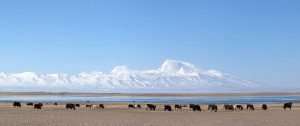Why a Baby Sleeping Bag made of Merino Wool?
Everyone knows how important healthy and safe sleep is for newborns. If your baby has an undisturbed sleep is also good for you, because you need to be fit for the challenges of a new day. Sleeping bags provide a strong feeling of security for your baby and are also much safer than blankets, which could shift at any time and lead to your child’s hypothermia.
But the range of baby sleeping bags is enormous and confusing. We will help you choose the right sleeping bag and tell you what the tog value of a sleeping bag means and what you should pay attention to when buying a sleeping bag for your newborn. Our guide will also tell you everything you need to know about the different types of baby sleeping bags and their manufacturers.
Buying advice for baby sleeping bags – We help you to choose the right sleeping bag for your newborn or toddler.
Why a Baby Sleeping Bag made of Merino Wool is the Best Choice!
What Types of Baby Sleeping Bags are there?
If you are facing the challenge of buying a baby sleeping bag, you will soon realize that there are very different baby sleeping bag variations. To get a better overview, here is a rough summary of the characteristics of the different types of baby sleeping bags.
Features
- independent of the season
- Freedom of movement
- longer dressing time
For 4 Seasons Sleeping Bags – Wool is the first choice, because wool has better thermo-regulating properties than cotton.
Features
- Foot openings allow for mobility when child is awaket
- Especially for toddlers
Your baby already starts to walk and get up in bed, and you are worried that your baby will trip with the sleeping bag? Then a baby sleeping bag with feet is just the right choice. Your baby is kept warm safely overnight and has the necessary leg space when needed.
Features
- strong feeling of security
- unborn childhood memory
- for newborns up to 6 months
Swaddling is a common practice that is used for centuries all over the world. Swaddling a baby has many advantages.
You should stop swaddeling when babies start to roll over from back to front, when they start trying to get out of the wrap or when swaddling disturbs their sleep.
Features
- especially designed for the cold or warm season
For very hot summer nights or if a moderate room temperature in the bedroom cannot be guaranteed.
Than you should choose sleeping bags specially designed for warm or cold temperatures.
What are the Advantages of Baby Sleeping Bags?
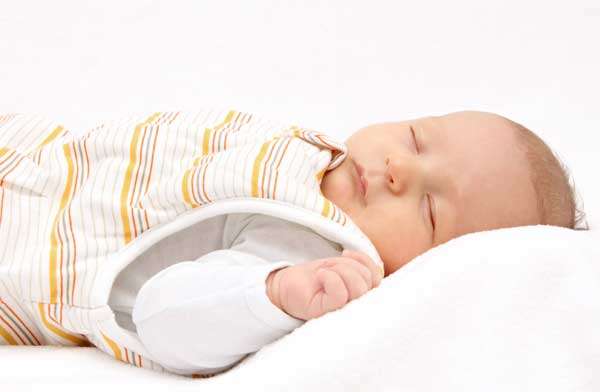
Your baby will sleep more securely in a suitable sleeping bag in the supine position and can turn less easily into the risky prone position.
With a suitable sleeping bag, you ensure that your child is always kept warm and secure, even when he or she pedals.
The danger of overheating or overcovering can be eliminated or significantly reduced by a suitable baby sleeping bag.
Unlike blankets, matching baby sleeping bags cannot be pulled over the head or kicked away.
Nowadays, baby sleeping bags are available for various room temperatures and in all imaginable sizes, including special models for premature babies or newborns.
Why a baby sleeping bag and not just a suitable blanket
As soon as adults freeze or shiver, they reach for the blanket and cover their body regions such as feet and legs to restore adequate body heat.
But with a newborn, the thing looks, unfortunately, somewhat more complicated. Simple blankets can shift at any time – a baby can neither communicate via words about which temperature is comfortable nor reach for the blanket and put it back in place.
This can have fatal consequences:
- The blanket shifts, and your child lies unprotected for hours during nap time or at night. Newborns can get hypothermia or freeze to death even at slight temperature differences since they lose body heat faster than adults.
- The Newborn moves, and the blanket wraps tightly over the baby’s head. So that the baby is deprived of air to breathe, in the worst case, your child may even suffocate.
The latter is the absolute horror of every parent’s imagination. To reduce the probability of sudden infant death, midwives and doctors will provide you with useful tips. The term ” sudden infant death ” is used to describe cases in which a previously healthy baby does not wake up from sleep. The reasons for this are various, but not always apparent at first glance.
Ensure that the sleeping environment is comfortable and air-conditioned and put your child in a supine position to minimize the risks. Thanks to baby sleeping bags, your baby will have a calm and safe as well as a healthy and, most importantly, safe sleep.
Everything you need to know about Baby Sleeping Bags.
Choose Natural Fibers – PureBaby
Tip: You should always ensure that the baby sleeping bag is made of relatively light and breathable material. Besides, your newborn baby's sleeping bag should always have a warm but not hot or humid climate. This can lead to overheating or hypothermia of your child. Natural fabrics are definitely preferable to synthetic fibers.
TOG Value of Baby Sleeping Bags and Bedroom Temperature
The TOG value (Thermal Overall Grade) was defined in England and is a unit of measurement for textiles’ thermal insulation. The value is standardized in England – this means that manufacturers cannot simply decide which sleeping bags have which TOG reference value.
TOG indicates the thermal insulation performance of a sleeping bag or more precisely: It defines how high the thermal resistance (multiplied by 10) of a material is. The thermal resistance R is measured in m2 K/W.
How high the baby sleeping bag’s tog value should be, depends on the temperature of the sleeping room. In general, the higher the TOG value of a baby sleeping bag, the warmer the baby will be at the same room temperature.
Here a general overview of the combination of sleeping bags with TOG value and bed textiles in the baby’s room:
- 0.2 TOG – Room temperature: above 27 °C (use onl diaper and perhaps a very light shirt)
- 0.5 TOG – Room temperature: 24-27 °C (use diaper and only a light shirt)
- 1.0 TOG – Room temperature: 21 – 24 °C (diaper with a light short bodysuit)
- 2.5 TOG – Room temperature: 18 – 21 °C ( with bodysuit long or perhaps short)
- 2.5 TOG – Room temperature: 15 – 18 °C ( shirt and long bodysuit)
For more details on the appropriate tog value of the sleeping bag and recommended clothing, please refer to the table on the right. »
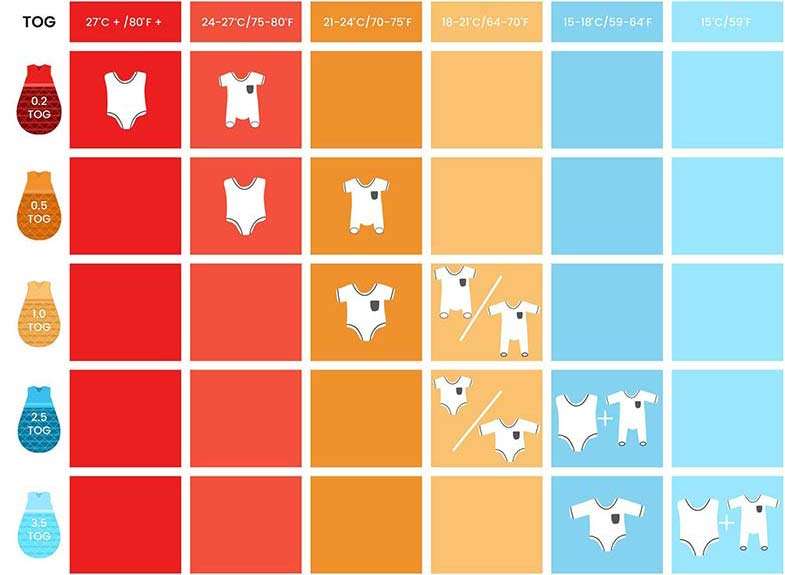
Caution: The values and suggestions in the table can only be considered as general guidelines! Please check your baby’s body temperature regularly to ensure that he or she is not sweating too much or even freezing.
Why a Baby Sleeping Bag made of Merino Wool
Merino wool perfectly regulates the body temperature and is the preferred material for producing four-season baby sleeping bags.
The soft fibers of merino wool are hollow and contain up to 85 percent insulating air. A baby sleeping bag made of merino wool is very breathable – it warms in winter and cools in summer.
On hot days, merino wool helps regulate body temperature- the fibers can absorb up to 35 percent of their weight in moisture and quickly release it to the outside. Merino wool does not absorb odors – foreign odors or heavy sweating do not bother this exclusive wool. A short airing of the sleeping bag is usually sufficient, and it feels like freshly washed.
Merino wool is dirt repellent and flame retardant. It ignites only at 560° Celsius and goes out immediately after the heat source is removed. Merino wool is also anti-static, and there is no unpleasant tingling on the skin due to the electrostatic charge.
Best Sleeping Bags for Babies - Merino Wool
* Disclosure: Links marked with Asterix or some picture links on world’s-finest-wool are affiliate links. – All our work is reader-supported – when you buy through links on our site, we may earn an affiliate commission. The decision is yours – whether you decide to buy something is entirely up to you.
Tip: Baby Sleeping Bags and the Requirements for Zippers
Zippers must meet the requirements of maximum safety for your baby. The zipper of a baby sleeping bag is attached either in the middle or on the side. If the zipper is positioned in the middle, it must be ensured that it can only be closed at the bottom to avoid injuries to your child’s neck.
Plus, only zippers with an automatic lock function should be used, as they cannot open by themselves due to your child’s movements. In principle, zippers on the side are more practical as they can be opened around the entire foot section, as your baby can be changed easily without first having to take off the entire sleeping bag.
Also, check the quality of the applied zipper – because inferior quality usually breaks down quickly!
How to choose the right size for a baby sleeping bag?
Very important is the question of the right size of the a baby sleeping bag.
Choosing the right size of the sleeping bag is essential because especially sleeping bags that are too big bear the risk of the child slipping in and thereby creating a cover situation. The choice of the size of a baby sleeping bag is mainly based on the body length of the child – so the sleeping bag must be adapted to the body measurements of the baby.
The standard size is “Body length – Head length + 10 cm”.
The additional 10 cm should give you some space to kick and grow into the sleeping bag but should not be exceeded because the sleeping bag is too big for your baby.
The perfect size of the neck and armholes
Also, pay attention to the size of the neck and armholes so that your baby cannot slip into the sleeping bag on the one hand. This could happen if the neckline is too large.
However, there should also be no danger of strangulation due to a too-tight neckline. There is also a rule of thumb for this – the neckline should be large enough to allow a finger to easily pass between the neck and neckline.
It is also very important that the armholes fit the size of the sleeping bag – too big armholes cause a higher heat loss, and there is also the risk that your baby slips into the sleeping bag.
There should not be any buttons or other devices to change the size of the neckline in the area of the armholes, as these can pose a potential risk.
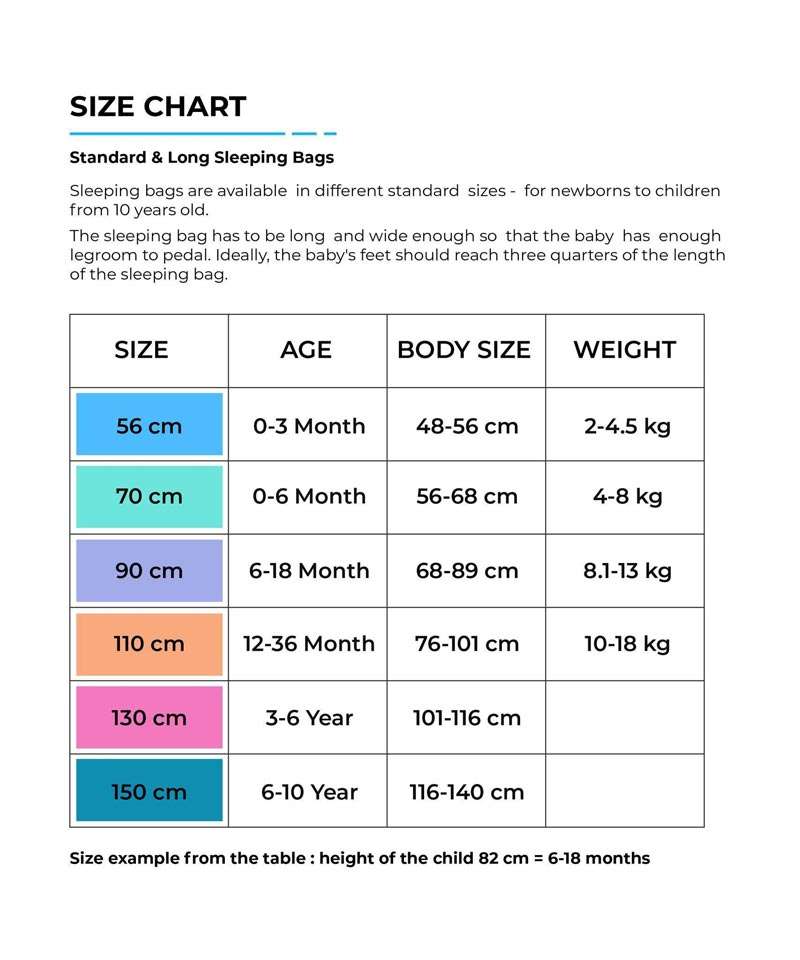
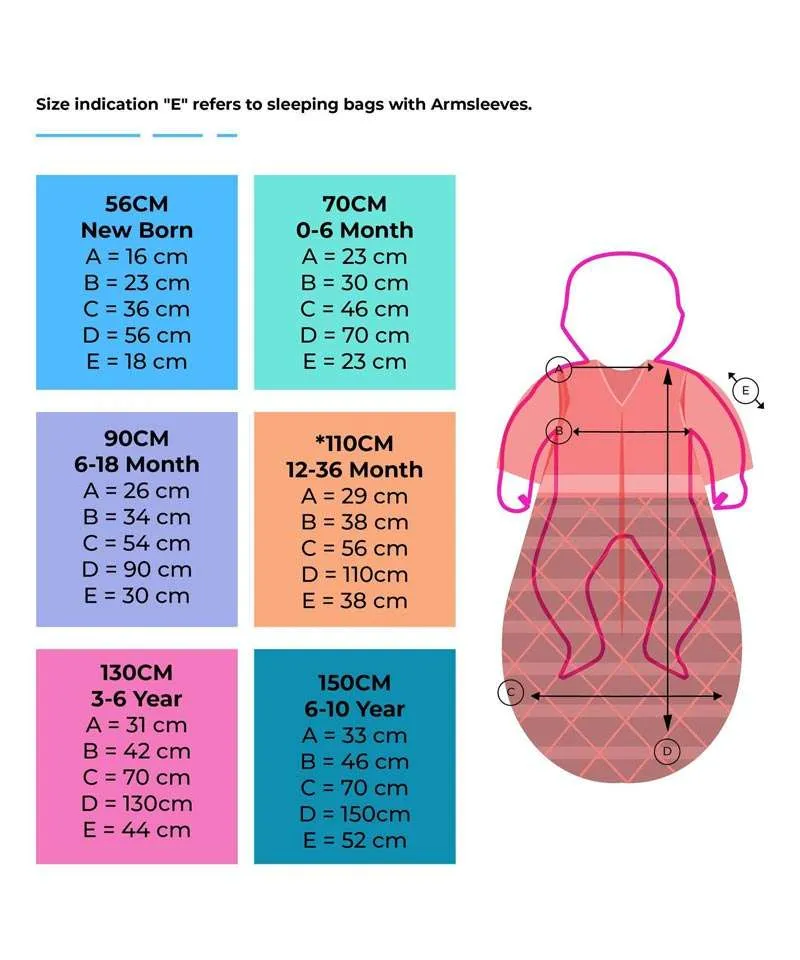
*With some sleeping bags, the length can be shortened by using snap fasteners or velcro. Please make sure that the neckline is still suitable for your child!
Caution: Always put your baby in the safe supine position for sleeping!
Baby Sleeping Sack - Processing and Materials
With regard to the processing and the materials used in the baby sleeping bag, there are also some important requirements.
When choosing a sleeping bag, you should always pay attention to high-quality, breathable materials. High breath-ability enables rapid absorption and release of moisture. Natural breathable organic materials like cotton or wool are the best choice.
It is also especially important that the back of the sleeping bag is as smooth as possible – as this lying surface should be as comfortable as possible and without disturbing knobs for your child.
Regarding the processed materials and manufacturing, the following points should also be taken into account:
Pilling Resistance – Pilling is the formation of nodules or fuzz on fabrics, with this fuzz occurring mainly on short-fiber fabrics.
No Azo Dyes must be processed – it is suspected that certain Azo Dyes have a carcinogenic potential.
Allergies: Substances that come in direct contact with the skin must not contain chemical brighteners – zippers and buttons should be nickel-free.
Label: No plasticizers, flame retardants, phosphorous, formaldehyde or heavy metal compounds may be used.
Baby sleeping bag weight maximum 10% of baby’s body weight
Best Sleeping Bags for Babies: Cotton -Sorted by TOG Value
Best Earliy Walker Sleeping Bags: Merino, Bamboo - Cotton
Table could not be displayed.
All about Swaddle Blankets
In many cultures, swaddling babies in blankets or large scarves has been very popular for thousands of years.
Especially in the days when there were no daycare facilities, and a lot of work had to be done by hand, it gave mothers the necessary flexibility and offered the babies an extra portion of sleep.
Swaddling makes the baby feel as if it is in the womb. Many babies also sleep deeper and firmer when they feel skin contact with the mother, and are wrapped in a swaddle blanket at the same time. It can also help parents to get their baby to sleep on its back.
It has also been shown to be helpful for babies with neurological problems or with colics – Or Babys who unfortunately have already been born drug-addicted. Without a doubt, swaddling will calm and soothe most babies and help them sleep longer. Some studies have shown that babies are calmer and also have lower and more stable heart rates.
Provided it is done correctly; swaddling is a wonderful and safe way to soothe and comfort your baby.
What are the Benefits of Swaddling a Baby
Swaddling Mimics The Mother’s Womb
Another advantage of swaddling a baby is that it soothes the effects of the so-called Moro reflex. The Moro reflex is a normal neurological reaction that makes a newborn baby feel like he is falling freely. In babies, this reflex occurs continuously during the first 3 to 4 months of life.
Swaddling a baby helps to maintain the optimal body temperature for the baby. Therefore, it is important to use a high quality breathable swaddling blanket made of natural material. The baby should also not be wrapped too thickly as this can lead to overheating – which can increase SIDS.
Unlike blankets, matching baby sleeping bags cannot be pulled over the head or kicked away.
Nowadays, baby sleeping bags are available for various room temperatures and in all imaginable sizes, including special models for premature babies or newborns.
Are there are also some risks to swaddling a baby?
It must also be mentioned here that swaddling babies can have some disadvantages. If, for example, the legs are held too tightly together, this can increase the risk of hip problems. If the baby is not swaddled properly, the fabric can come loose, and there is a risk of suffocation!
A study published in Pediatrics found that swaddling can increase the risk of SIDS, especially when babies are laid on their side or on their stomachs. Especially for babies over six months of age who were laid on their bellies, the risk of SIDS doubled.
Please Consider: What works well for some babies does not necessarily work well for your child. Babies do not necessarily have to be swaddled – if your baby has a healthy sleep and is happy even without swaddling, then don’t bother.
Be well informed when you plan to swaddle your baby – always lay your baby on his or her back to sleep. This is especially important when swaddling your baby.
Always lay a swaddled baby on its back to sleep, never on its side or on its belly! Stop swaddling immediately as your baby starts to turn on its side or belly.
Use thin, breathable materials for swaddling. Suitable materials include cotton blankets, cotton-muslin Swaddles, or special baby Swaddles with cotton wings. Some of them are also available made of fine Merino Wool.
Never swaddle your baby too tight – the hips and legs must still be able to move! Do not swaddle the baby over the shoulders – the neck and head must always remain uncovered. Get professional help to learn it perfectly!
Please check the temperature of your baby regularly! This will ensure that your baby does not overheat under the blanket. Make sure that your baby is dressed according to the weather.
Do not double up several blankets when wrapping. The extra thickness can cause your baby to overheat. The blanket may also come loose more easily, which increases the risk of suffocation.
If someone else needs to care for your baby, make sure this person is well informed about advice on safe sleeping and nappy changing. Make sure that carers know that the baby should always sleep on its back.
USEFUL RESOURCES:
Best Swaddle Blankets for Babies
How to properly care for a baby sleeping bag
No matter which sleeping bag you choose: The right care of the sleeping bag is crucial for a long-lasting, fluffy fabric experience and a calm and secure sleep for your child. To guarantee this, we have dealt with the most frequently asked questions about the care for baby sleeping bags.
How often should a baby sleeping bag be washed?
Since your baby spends a lot of time in his sleeping bag, it is important to wash the sleeping bag regularly. Experience shows that once a week is sufficient. But also here you should first of all take care of your baby: If he spits often or sweats excessively, the sleeping bag should be cleaned more often.
What is the best way to wash a baby sleeping bag?
From model to model, the care recommendations differ. Therefore, it is worthwhile to first study the manufacturer’s instructions regarding the correct care of the sleeping bag.
As a rule, baby sleeping bags are washable up to 40°C in the normal program, but there are exceptions that should be washed in the gentle program. Some models can also be washed at 60 °C, which is a great advantage, especially for leaking diapers.
If you buy a down sleeping bag, the care is even more complicated. These are usually washed at 30 to 40 °C in a gentle wash cycle or a special down program. You should avoid adding detergent to both down, and cotton sleeping bags as this can have a harmful effect on your baby’s skin. A conventional liquid or powder detergent is completely sufficient here.
Tip: When washing your down sleeping bag, you can add one or two tennis balls or dryer balls into the drum to prevent the down from clumping together.
Frequently Asked Questions about Baby Sleeping Bags and Safety
We hope we could help you with the purchase decision for your preferred baby sleeping bag for your newborn. If you still have questions, we have the most frequently asked questions and answers for you.
The term Sudden Infant Death means that a child dies without warning and without any apparent cause. Doctors and scientists diagnose SIDS when, even after thorough examination, they cannot identify any other cause of death. For the parents concerned, sudden infant death is a catastrophe.
Unfortunately, sudden infant death cannot be 100% prevented. However, there are some measures that reduce the risk of SIDS.
Sudden infant death: Prevention:
Put your child on its back to sleep
The most effective measure against SIDS is not to lay the baby on its stomach to sleep. Lay it on its back. Your baby can breathe well in this position.
The less bedding, the better
You should also not put any additional sheets, pillows, cuddly toys or animal skins in your bed. This can quickly make your child feel too warm. In addition, it may not be able to breathe freely. Make sure you have a firm sleeping surface. This prevents your child from sinking in too much. Also, avoid down blankets and pillows.
Use a sleeping bag
Ideally, you should put your child into a sleeping bag to sleep. This should be of a size appropriate to the age of the child. It ensures a constant temperature. Above all, it prevents the child from turning into a prone position, which can lead to sudden infant death.
Avoid too much heat
A sleeping room temperature of about 18 degrees Celsius is completely sufficient for your child. It also reduces the risk of sudden infant death.
Leave your baby in his bed, but not alone.
This point has been discussed in the past as a SIDS risk factor. Some scientists believe that sleeping in the parental bed reduces the risk of sudden infant death. One study, however, says that newborns are said to be even more affected by sudden infant death in so-called co-sleeping.
Therefore, put your child in a separate bed of its own and place it next to your parents’ bed. This will enable you to take timely action in an emergency and prevent sudden infant death.
Attend the preventive appointments at the pediatrician
Regular preventive medical checkups are important to detect possible diseases or developmental disorders in the infant at an early stage. Your pediatrician can also give you useful advice on how to prevent sudden infant death.
Breastfeeding and soothers might protect
Even if one does not know the reason exactly: Several studies showed that the pacifier lowers the risk for sudden infant death on an average up to 30 percent.
Smoke-free environment!
Smoking increases the risk of sudden infant death. So do not smoke either during or after pregnancy. This also applies to the father, relatives and friends who are near the baby or pregnant woman.
Read more about preventing SIDS HERE!
Through a variety of different preventive measures – such as the supine position as a safe sleeping position for the baby – the frequency of Sudden Infant Death could be reduced by more than two-thirds.
Among the avoidable risk factors are covering and overheating of the baby. Both can be prevented by using suitable baby sleeping bags. This has been proven by several studies.
Often parents ask if they should use a blanket with a baby sleeping bag? No, you should not use a baby sleeping bag with an additional blanket. Modern baby sleeping bags are designed to be used alone, without an extra blanket, so your baby will not overheat.
At what age can babies sleep on their stomachs?
Pediatricians recommend that babies should not sleep on their stomachs until after their first birthday. In this phase, babies can usually sit without support and roll from back to front.
But what do you do if your baby rolls onto his or her tummy while sleeping earlier?
You cannot monitor your baby 24 hours a day!
If your child is over six months old and already has good head and trunk control, then he or she is usually strong enough to turn back on their own back. It is then no longer necessary to turn the baby on its back. If you get up at night and your baby sleeps on your belly, you can, of course, put him or her on your back again.
Infants between the first and fourth month of life are most at risk.
About 90 percent of cases occur in infants under six months of age. Usually, SIDS does not occur after a child’s first birthday.
In this case, – the baby’s safety is more important than sleeping comfort. Parents should put the baby on his back to sleep, even if he feels less comfortable or has a more restless sleep.
If babies wake up more often at night, this is normal, and there is no need to worry immediately.
Many newborns do not like to sleep on their backs at first, but most of them get used to it quite quickly.
Until when your baby needs this sleeping bag, it is difficult to make a general statement about the age of your baby. Therefore you should rather base your decision on the size of your baby.
Baby sleeping bags are usually available in sizes up to 130 cm. If your child exceeds this size, it is time to switch to blankets and pillows. However, children usually refuse to sleep in a sleeping bag for any longer than this from the age of about 2 to 2.5 years. So, in the end, it always depends on your own child’s attitude.
Under the sleeping bag, depending on the outside temperature, simple cotton clothing is sufficient. You can take a look at the Tog Value table for reference.
As a rule, no additional blanket is necessary above the sleeping bag. However, this can still provide a greater feeling of security for your baby. But here, too, we recommend that you first and foremost pay attention to your baby’s perception and use touch to determine whether your baby needs additional clothing or not.
Cool hands and feet are normal for babies. Cold and pale blue marbled hands and feet are a sign that your baby is too cold. To find out if your baby is cold or sweating, it is best to place two fingers in the neckline at the back of the neck: If the neck skin is cold, it may be freezing. If the skin there is warm and moist, the baby is too hot. A red head also indicates that the baby is too warm.
Babies lose much more heat through their skin because their body surface is larger in relation to their body volume than adults. And a lowered body temperature makes them more susceptible to pathogens. In most cases, however, the reason for a sneezy baby is not a winter walk but contact with siblings or relatives who are already ill. If a wave of flu is even to be feared, parents should not expose their baby to too many external contacts in order to keep the risk of infection low.
Since babies lose a lot of heat through their head and hands, it is important to wear a soft baby hat and light mittens in cool temperatures below 18 degrees Celsius to give your little one an extra layer of warmth.
During the first 6-12 weeks, your baby should always wear a cap when outside. The cap prevents heat loss and protects against the sun. A cotton cap is especially recommended for newborns, as it protects the head and ears.
Scientific studies show that the back sleeping position carries the lowest risk of SIDS.
There is no scientific evidence that swaddling reduces the risk of SIDS.
Unfortunately, improper swaddling can increase the risk of SIDS and other sleep-related causes of infant death. If you made the decision to swaddle your newborn, always lay him or her on the backs completely for sleeping. Immediately stop swaddling your baby as soon as he or she tries to turn over.
CAUTION! All content on this website has been created for information purposes only. The content is not intended as a substitute for professional medical advice, diagnosis or treatment. Always seek a pediatrician or other qualified healthcare provider's advice if you have questions about how to best care for your baby. Never disregard professional medical advice or hesitate to seek it because of something you have read on this website.
USEFUL RESOURCES:
Thank you for joining this comprehensive Guide about the Best Sleeping Bags for Babies.
Did you already buy a Baby Sleeping Bag? What are your experiences? We are very much interested in reading from you – leave us a comment.
Marco Heitner

Have You Ever Heard Of The Magical Nubra Valley?

Guanaco vs Vicuña: A Detailed Exploration of their Differences and Similarities

Angora Rabbit Wool Harvesting: A Sustainable and Ethical Journey
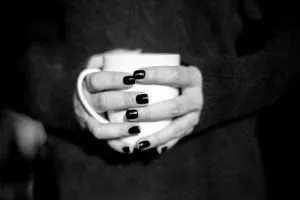
The Cultural Significance of Cashmere: A Symbol of Wealth, Luxury, and Status

Discovering Resort at its finest: All about Mahogany Bay Village on Ambergris Caye

From Beginner to Expert: Your Guide to Crochet Granny Square Easy

Arequipa’s Alpaca Magic: Industry Insights, Tours, and Shopping Gems

Being Adventurous in Fort Lauderdale

Alpaca Coats and Alpaca Ponchos


